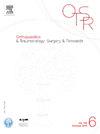使用两种学习方法研究锁骨钢板植入术的手术表现:天真练习与刻意练习。
IF 2.3
3区 医学
Q2 ORTHOPEDICS
引用次数: 0
摘要
背景:陪伴和简单的经验或天真练习(NP)很少能使外科手术达到专家水平,相比之下,刻意练习(DP)则是由专家分析学习者的错误并设定目标以提高成绩。主要假设是,使用 "刻意练习 "进行学习会比使用 "天真练习 "取得更快和/或更大的进步:这项工作的目的是比较通过两种不同方法(NP 和 DP)学习的外科学员在锁骨骨折锯骨模型上放置锁骨锁定钢板的学习曲线的变化情况:10 名外科住院医师分为 2 组,每组 5 人,每组放置 6 块钢板。这 6 次试验都被拍摄下来。NP 组在每次放置前观看专家视频。DP组观看一次视频,然后在每次试验后分析自己的视频,接受专家的个性化改进建议。客观表现(OP)通过标准化评估网格(OSATS,每次试验得分从 10 分到 50 分不等)进行测量,自我评价通过数字量表(从 0 到 10)进行测量,压力通过镇痛-痛觉指数(ANI,通过心率记录计算,从 0 到 100)进行测量:最后一次锁骨钢板置入试验的平均 OP 值为 41.8(NP 组)和 48.2(DP 组),从第一次试验到最后一次试验的平均进度为:NP 组 0.8,DP 组 5.1。从第一次试验到最后一次试验,自我评价的平均进展为 3.4(NP 组)和 4.6(DP 组)。在第一次和最后一次试验之间,ANI的平均进步幅度为-4.5(NP组)和+5(DP组):讨论:以OSATS衡量的锁骨钢板截骨技术学习效果,刻意练习优于盲目练习。讨论:通过 OSATS 测定的学习锁骨钢板截骨技术的效果要好于单纯练习,刻意练习的自我评估成绩进步更好,但压力水平更高:结论:刻意练习是一种学习外科手术的技巧,与陪伴和经验相辅相成。结论:刻意练习是一种学习外科手术的技巧,是对陪伴和经验的补充,它缩短了学习曲线,提高了外科学员的表现水平:证据等级:IV;非干预性研究。本文章由计算机程序翻译,如有差异,请以英文原文为准。
Study of surgical performance during clavicle plate placements using 2 learning methods: naive practice versus deliberate practice
Background
Companionship and simple experience or naive practice (NP) rarely lead to expert level surgery, in contrast to deliberate practice (DP) where an expert analyzes the learner's errors and sets goals to improve performance. The main hypothesis was that using DP for learning would result in faster and/or greater progress than using NP.
Objectives
The objective of this work was to compare the evolution of the learning curve for clavicle locking plate placement on a sawbone model of a clavicle fracture, by surgical trainees learning via two different methods; NP and DP.
Patients and methods
Ten surgical residents, divided into 2 groups of 5, each placed 6 plates. The 6 trials were filmed. The NP group saw an expert video before each placement. The DP group saw this video once and then received personalized advice from the expert for improvement, by analyzing their own video after each subsequent trial.
Objective performance (OP) was measured by a standardized evaluation grid (OSATS, with a score ranging from 10 to 50 points per trial), self-evaluation of performance by a numerical scale (from 0 to 10) and stress by an analgesia-nociception index (ANI, calculated by heart rate recording, from 0 to 100).
Results
The mean OP at the last trial of clavicle plate placement was 41.8 (NP group) and 48.2 (DP group), with a mean progression from the first to last trials of 0.8 in the NP group, and 5.1 in the DP group. The mean progression in self-evaluation between the first and last trials was 3.4 (NP group) and 4.6 (DP group). The mean progression of the ANI between the first and last trials was -4.5 (NP group) and +5 (DP group).
Discussion
The results of learning a clavicle plate osteosynthesis technique measured by OSATS were better with deliberate practice than with naive practice.
The progression in self-evaluated performance was better with deliberate practice, but with a higher stress level.
Conclusion
Deliberate practice is a technique for learning the surgical procedure which complements companionship and experience. It shortens the learning curve and improves the level of performance of surgical trainees.
Level of evidence
IV; non-interventional research
求助全文
通过发布文献求助,成功后即可免费获取论文全文。
去求助
来源期刊
CiteScore
5.10
自引率
26.10%
发文量
329
审稿时长
12.5 weeks
期刊介绍:
Orthopaedics & Traumatology: Surgery & Research (OTSR) publishes original scientific work in English related to all domains of orthopaedics. Original articles, Reviews, Technical notes and Concise follow-up of a former OTSR study are published in English in electronic form only and indexed in the main international databases.

 求助内容:
求助内容: 应助结果提醒方式:
应助结果提醒方式:


